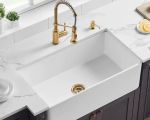How to Choose the Right Countertops for Your Bathroom
May 02, 2025
How to Choose the Right Countertops for Your Bathroom
Choosing the right countertops for your bathroom is more than just about aesthetics—it’s about durability, maintenance, and functionality. As I began remodeling my own bathroom, I was overwhelmed by the wide variety of countertop materials and styles available. From luxurious marble to practical granite, each material has its own set of pros and cons, making it crucial to select the one that suits both your needs and your budget. After much deliberation, I came up with a set of guidelines that I’ll share here to help you navigate through the process of choosing the right bathroom countertop.
1. Consider the Size and Layout of Your Bathroom
Before diving into materials, it’s important to assess your bathroom's size and layout. The size of the bathroom will greatly influence how much countertop space you need. Smaller bathrooms might require compact vanities, while larger bathrooms can afford to have expansive countertops.
For my remodel, I measured the space available around the sink and determined that I could fit a larger countertop with dual sinks. If your bathroom is smaller, you may want to opt for a minimalist design with sleek, smaller countertops to avoid overcrowding the space. When you consider size, think about both the visual impact and practicality—do you need space for a lot of toiletries or just enough to accommodate daily essentials?
2. Choose a Material That Suits Your Style
The material you choose for your bathroom countertop plays a significant role in the overall style and feel of your bathroom. Traditional options like marble and granite can offer an elegant and timeless appeal, while modern materials like quartz and concrete lend a more contemporary touch.
For my bathroom remodel, I was drawn to quartz countertops because they are known for their versatility and wide range of designs. Quartz offers the look of natural stone without the maintenance that comes with materials like granite or marble. If you want a classic look, marble countertops might be the way to go, as they exude luxury and sophistication, but be aware of their susceptibility to staining and scratching.
Here are some common countertop materials and the style they typically complement:
- Granite: Perfect for classic or rustic-style bathrooms.
- Quartz: Works well with modern or minimalist bathrooms due to its clean, uniform appearance.
- Marble: Ideal for luxurious, vintage-style bathrooms.
- Wood: A great choice for farmhouse or natural-style bathrooms, offering warmth and charm.
3. Think About Durability and Maintenance
Durability is crucial, especially in a bathroom where surfaces can experience exposure to water, soap, and cleaning products. I learned that quartz countertops were an excellent option for durability, as they are resistant to scratches, stains, and moisture. On the other hand, while marble looks beautiful, it’s a porous material that requires regular sealing and careful maintenance to avoid stains and discoloration.
For a bathroom countertop that requires minimal upkeep, I recommend choosing materials like quartz, granite, or concrete. These materials are much easier to clean and maintain compared to others like marble or wood. If you have kids or pets, durable options may be more practical for you.
4. Budgeting for Your Countertop
When choosing a bathroom countertop, budgeting plays a significant role. Materials like marble and high-end granite can be quite expensive, while options like laminate or wood may be more budget-friendly. It’s essential to consider both the initial cost of the countertop as well as any long-term maintenance costs.
I spent quite some time evaluating my options within my budget. Quartz came out as an ideal middle ground—more affordable than marble but still offering a sleek, sophisticated look. If you're on a tight budget, you might want to explore alternatives like engineered stone or high-quality laminate, which can provide the look of more expensive materials at a fraction of the cost.
5. Assessing the Climate and Environment
Another consideration that often gets overlooked is the climate and environment of your home. For example, if you live in a very humid area, certain materials may not be as suitable for your bathroom as others. Wood, while beautiful, can warp and crack over time in humid conditions unless treated correctly.
For a more humid environment, materials like granite, quartz, or concrete are perfect, as they don’t absorb water and are less likely to sustain damage from moisture. These materials are built to withstand the bathroom’s high humidity and frequent contact with water.
6. Functionality and Additional Features
Finally, when selecting a countertop, think about additional features you might want to integrate. For instance, do you want an integrated sink for a seamless look? Or perhaps extra counter space for storing toiletries and bathroom essentials?
For my bathroom, I opted for a countertop with an integrated sink, which made cleaning much easier. I also chose a countertop with enough space to place everyday items like soap dishes, toothbrush holders, and skincare products. Make sure the countertop you choose aligns with your daily needs.
7. The Role of Color in Your Bathroom Countertop Choice
Color plays an important role in setting the tone for your bathroom. Neutral colors like whites, creams, and grays tend to make the space feel light and airy, whereas darker colors like navy or charcoal create a more sophisticated, intimate feel.
In my own bathroom, I decided on a soft beige quartz countertop that complemented the light gray tiles and white fixtures. The combination created a calm, welcoming space. Consider the existing color palette of your bathroom before making a final decision to ensure the countertop enhances the overall aesthetic.







